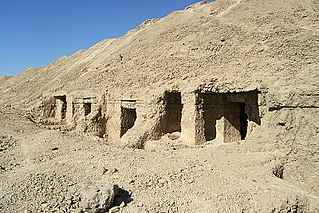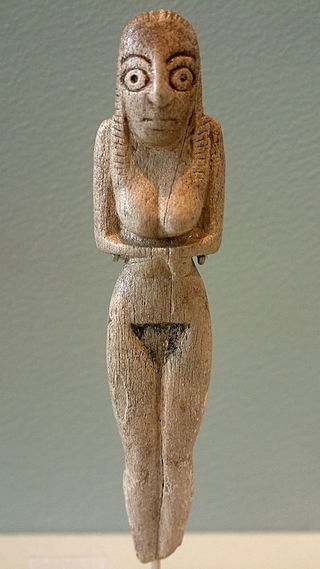
Egyptology is the scientific study of ancient Egypt. The topics studied include ancient Egyptian history, language, literature, religion, architecture and art from the 5th millennium BC until the end of its native religious practices in the 4th century AD. A practitioner of the discipline is an "Egyptologist".

Panties (AmE) or knickers (BrE) are a form of underpants worn by women. Panties can be form-fitting or loose. Typical components include an elastic waistband, a crotch panel to cover the genitalia, and a pair of leg openings that, like the waistband, are often made of elastomer. Various materials are used, but are usually chosen to be breathable.

Hotepsekhemwy is the Horus name of an early Egyptian king who was the founder of the Second Dynasty of Egypt. The exact length of his reign is not known; the Turin canon suggests an improbable 95 years while the ancient Egyptian historian Manetho reports that the reign of "Boëthôs" lasted for 38 years. Egyptologists consider both statements to be misinterpretations or exaggerations. They credit Hotepsekhemwy with either a 25- or a 29-year rule.

Abusir is the name given to an ancient Egyptian archaeological pyramid complex comprising the ruins of 4 kings' pyramids dating to the Old Kingdom period, and is part of the Pyramid Fields of the Memphis and its Necropolis UNESCO World Heritage Site.
The Badarian culture provides the earliest direct evidence of agriculture in Upper Egypt during the Predynastic Era. It flourished between 4400 and 4000 BC, and might have already emerged by 5000 BC.
Naguib Kanawati is an Egyptian Australian Egyptologist and Professor of Egyptology at Macquarie University in Sydney, New South Wales, Australia.

Winifred Mabel Bruntonnée Newberry was a South African painter, illustrator and Egyptologist.

El Hawawish is the ancient necropolis (cemetery) for the city of Akhmim in the 9th Nome of Upper Egypt (UE09), in modern the Sohag Governorate, Egypt.

John Garstang was a British archaeologist of the Ancient Near East, especially Egypt, Sudan, Anatolia and the southern Levant. He was the younger brother of Professor Walter Garstang, FRS, a marine biologist and zoologist. Garstang is considered a pioneer in the development of scientific practices in archaeology as he kept detailed records of his excavations with extensive photographic records, which was a comparatively rare practice in early 20th-century archaeology.

Gertrude Caton Thompson, was an English archaeologist at a time when participation by women in the discipline was uncommon. Much of her archaeological work was conducted in Egypt. However, she also worked on expeditions in Zimbabwe, Malta, and South Arabia. Her notable contributions to the field of archaeology include creating a technique for excavating archaeological sites and information on Paleolithic to Predynastic civilizations in Zimbabwe and Egypt. Caton Thompson held many official positions in organizations such as the Prehistoric Society and the Royal Anthropological Institute.

Guy Brunton was an English archaeologist and Egyptologist who discovered the Badarian predynastic culture. He married Winifred Newberry on 28 April 1906. Her father built Prynnsberg Estate. He served in the First World War and returned to archaeology becoming assistant director of the Cairo Museum in 1931, he retired to South Africa.
Henry Reginald Holland Hall MBE, FBA, FSA was an English Egyptologist and historian. In life, he was normally referred to as Harry Reginald Hall.

Barbara Georgina Adams, FRSA was a distinguished British Egyptologist, archaeologist, and academic, who was a specialist in Prehistoric Egypt. She worked for many years at Hierakonpolis, where she was the co-director of the expedition. She worked at the Petrie Museum of Egyptian Archaeology in London, latterly as curator (1984–2001), and also worked on excavations across Britain.

El Badari is a town in the Asyut Governorate, Upper Egypt, located between Matmar and Qaw El Kebir.

Gebelein was a town in Egypt. It is located on the Nile, about 40 km south of Thebes, in the New Valley Governorate.
Gianluca Miniaci is an Italian Egyptologist, currently Associate Professor at the University of Pisa.

Hilda Mary Isabel, Lady Petrie, was an Irish-born British Egyptologist and wife of Sir Flinders Petrie, the father of scientific archaeology. Having studied geology, she was hired by Flinders Petrie at age 25 as an artist, which led to their marriage and a working partnership that endured for their lifetimes.
May was an ancient Egyptian official of the New Kingdom who was in office under Pharaoh Thutmose III.
Letters to the Dead are a corpus of ancient Egyptian texts found from the Old Kingdom through to the Late Period. They address a deceased relative asking for help with problems of inheritance, illness or fertility.














